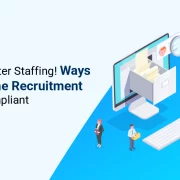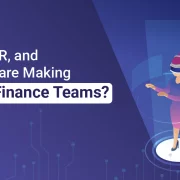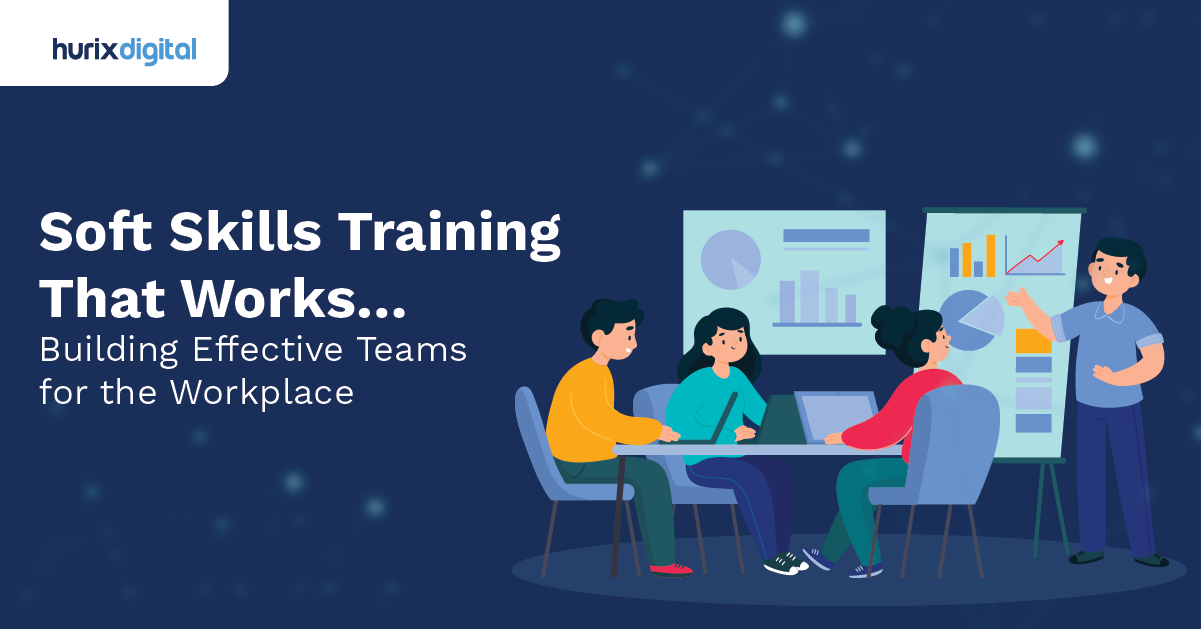
Soft Skills Training For Employees – Building Effective Teams for the Workplace
For decades, businesses have struggled with the lack of soft skills in employees at all levels of the corporate hierarchy. This scenario applies to fresh hires, employees on the growth track, as well as senior management.
The lack of effective soft skills training for employees in college and professional courses has nudged some businesses to invest in closing this gap themselves. Statistics indicate a growth in business spending on the soft skills training market, which is expected to grow from $25.8 billion in 2022 to $63.6 billion by 2030.
However, unlike domain skills, soft skills are more challenging to build. They must be nurtured in a live environment, with practice and hands-on experience. This is where online learning, or eLearning, offers several advantages over traditional classroom lectures.
In this blog, we deconstruct contemporary soft skill-building methods in a technology-led, sustainable training environment.
Table of Contents (Jump To):
- What is Soft Skills Training?
- How is eLearning Revolutionising Soft Skills Training?
- Top 10 Methods for Soft Skills Training for Employees
- Understanding Localization in Soft Skills Training
- Challenges of Idioms and Colloquialisms
- Strategies for Effective Localization
- Best Practices for Localizing Soft Skills Training
- The Takeaway
What is Soft Skills Training?
Soft skills training refers to structured programs designed to empower workforces in the cultivation of professional attitudes, social skills, and characteristics, which drive effective business outcomes.
A recent survey identified the top 10 emerging soft skills in demand at the workplace. In the top 25% wage bracket, strategic thinking emerged as the top soft skill in 65% of job advertisements for higher-paid roles. The other nine skills include negotiation, persuasion, presentation skills, critical thinking, mentoring, innovation, emotional intelligence, financial management, and resilience.
Each soft skill can be further sliced into multiple skills. For example, emotional intelligence comprises Self-awareness, Empathy, motivation, and Social skills, while critical thinking comprises Analysis, Evaluation, Deductive reasoning, and Synthesis.
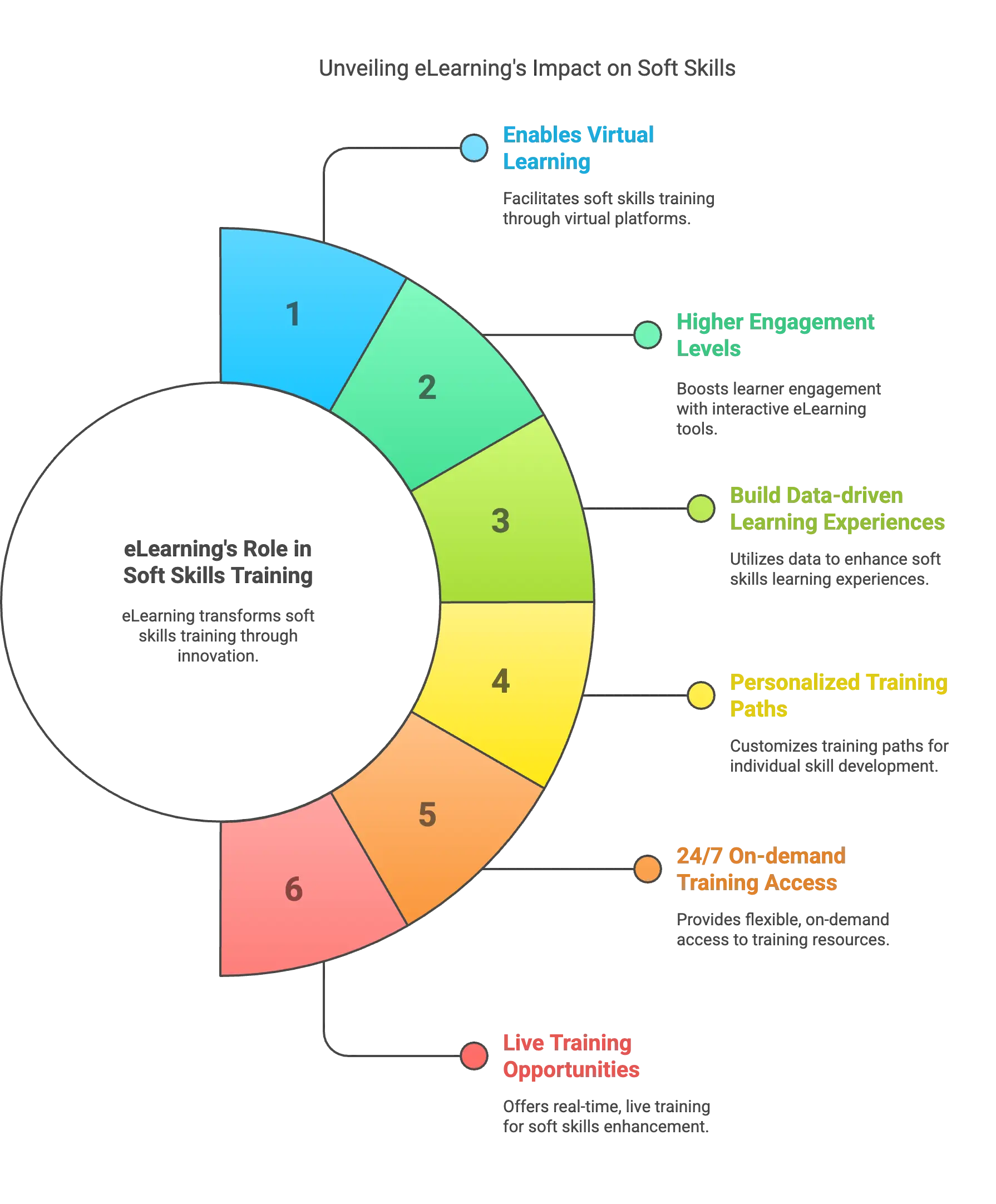
How is eLearning Revolutionising Soft Skills Training?
Today, eLearning has evolved significantly with the growing adoption of technologies such as Artificial Intelligence (AI), Machine Learning (ML), Virtual Reality, Augmented Reality, Gamification, and Robotic Automation.
Here’s a snapshot of how contemporary eLearning adds value to soft skills training for employees:
1. Enables Virtual Learning
One of the biggest advantages of eLearning is that businesses can eliminate traditional infrastructure requirements such as conference room set-ups, facilitators, and logistics management. Workers can learn online from their mobile phones, and they can log in anytime from wherever they are located.
This arrangement works well for traditional workforce set-ups, hybrid workforces, and remote workforces. Businesses can offer remote training programs across geographies and onboard new hires on their learning platforms from Day 1. This aspect reduces costs and efforts invested in soft skills training for employees.
2. Higher Engagement Levels
Online training has the potential to make learning an interactive, accessible, and inclusive experience.
Instructors can create interactive course material that leverages the power of videos, audio representations, podcasts, eBooks, infographics, slides, live video sessions, and 3D models. Gamification, social learning, and collaborative projects can further enhance interactivity.
3. Build Data-driven Learning Experiences
A superior AI-powered Learning Management System (LMS) comes with in-built AI-based predictive analytics, which can forecast trends, and offer insights to instructors designing the content.
Businesses can also access team members’ learning patterns, which modules are working well, and how future programs can be designed to bridge learning gaps. Team members’ progress can be tracked every day, and training content can be designed accordingly.
4. Personalized Training Paths
Working professionals have diverse roles and capabilities. Hence, standardized training programs are not effective in bridging all the gaps.
eLearning has paved the way for personalized training paths, an opportunity where a team member’s soft skills training can be customized per their specific needs. Personalization can drive higher engagement and boost learning effectiveness.
5. 24/7 On-demand Training Access
Today, professionals seek flexibility in their learning journeys. In this regard, 24/7 access to a rich digital library of dedicated employee training resources allows professionals to learn as per their schedules and needs.
For instance, if a team member has to prepare for a challenging sales pitch, they can access videos or eBooks with relevant sales and negotiation content. This type of access makes the learning journey more relevant and accessible to real-time needs.
6. Live Training Opportunities
Hands-on experience is an essential aspect of soft skills training. In traditional learning methods, for instance, facilitators may use role plays to simulate various workplace scenarios where soft skills are needed.
However, this process is cumbersome to organize and costly to execute. The adoption of AR and VR in eLearning is addressing this challenge. A VR-based soft skills training cohort, comprising a select group of new managers based in 12 US locations, indicated that:
- Learners were 4X times faster to train than in a classroom
- % more likely to apply skills learned after the training
- 75X times more emotionally connected to content.
Live simulations using AR/ VR technologies enable professionals to participate in potential work scenarios to enhance their skills. The setting of these environments can be changed to simulate a wide range of scenarios. Thus, professionals can keep practicing and enhancing their skills.
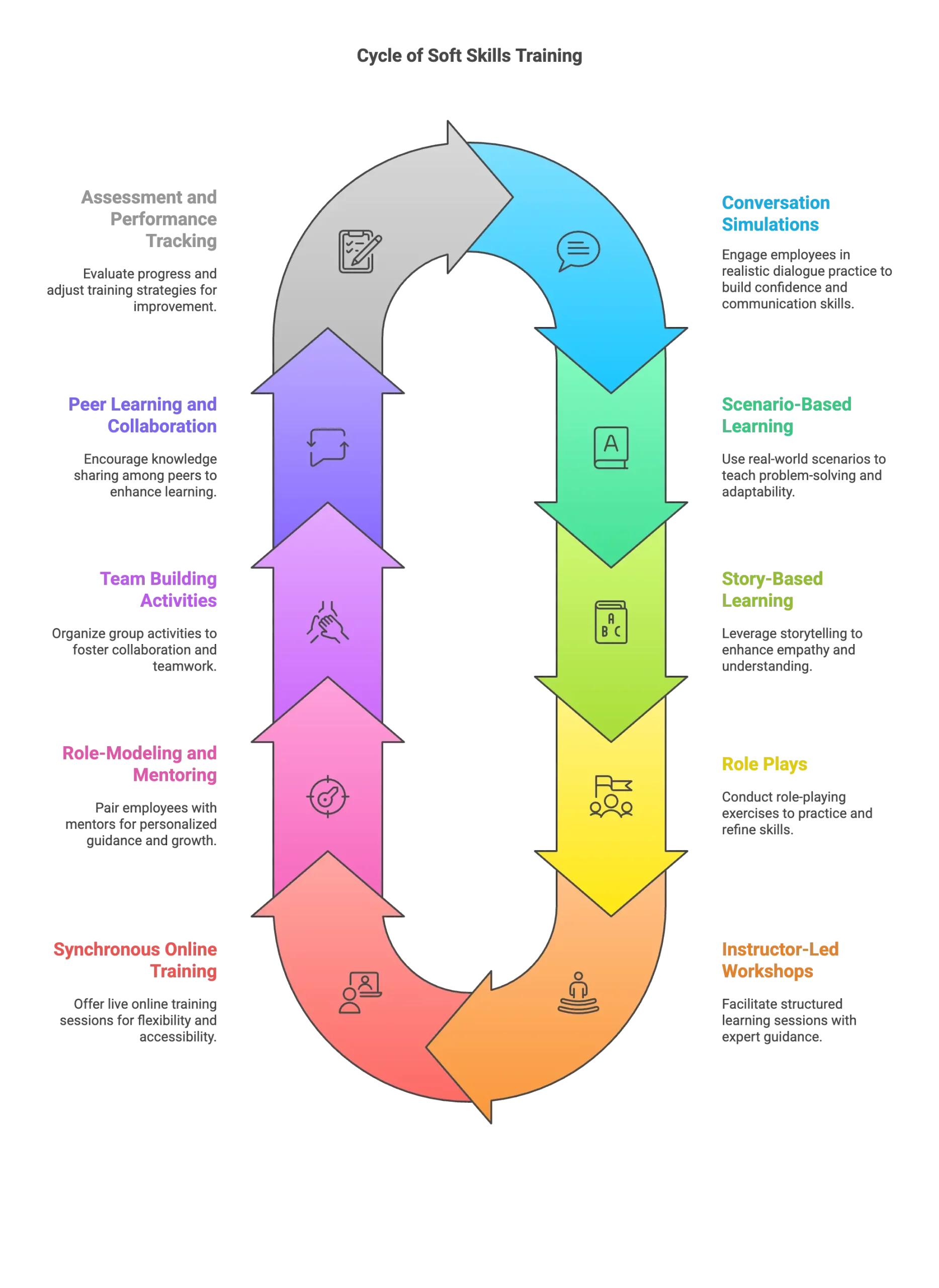
Top 10 Methods for Soft Skills Training for Employees
Let’s have a look at some of the tried-and-tested methods to encourage soft skills training for employees:
1. Conversation Simulations
Conversation simulations are immersive training exercises that replicate real-life conversations and interactions. They provide employees with a safe and controlled environment to practice and refine their communication and interpersonal skills. These simulations often use interactive technology to simulate realistic scenarios, allowing participants to converse with virtual characters or avatars.
By experiencing various challenging situations and receiving immediate feedback, employees can develop their ability to communicate effectively, empathize, and handle difficult conversations.
2. Scenario-Based Learning
Scenario-based learning involves presenting employees with realistic scenarios or case studies that reflect everyday workplace situations. Participants are tasked with analyzing the scenario, making decisions, and solving problems using their soft skills. These scenarios are designed to encourage critical thinking, decision-making, and the application of various soft skills in a practical context. By engaging in scenario-based learning, employees develop their problem-solving abilities, adaptability, and communication skills while understanding the consequences of their actions within a simulated environment.
3. Story-Based Learning
Story-based learning utilizes narratives or storytelling techniques to convey important lessons and principles related to soft skills. Stories have a powerful impact on human cognition and engagement, making them an effective tool for learning. Through compelling narratives, employees can relate to characters, empathize with their experiences, and gain insights into different soft skills and their applications. Story-based learning enhances retention and understanding, allowing employees to internalize and apply soft skills concepts in their work and interactions.
4. Role Plays
Role plays involve participants taking on different roles in simulated scenarios to practice and improve their soft skills. Participants can experience different perspectives and engage in realistic interactions by assuming specific roles. Role plays allow employees to apply their communication, empathy, problem-solving, and conflict-resolution skills in a dynamic and interactive setting.
Role plays provide opportunities for immediate feedback, reflection, and learning from experiences. They also encourage creativity and adaptability as participants adapt their behaviors and responses based on the roles they embody.
5. Instructor-Led Workshops
Instructor-led workshops provide valuable opportunities for employees to engage in interactive sessions, group activities, and role-playing exercises. These workshops facilitate hands-on learning, immediate feedback, and peer collaboration, enabling employees to enhance their soft skills through practical application.
6. Synchronous Online Soft Skills Training
Synchronous online soft skills training for employees offers a dynamic and interactive learning experience that combines the benefits of live instruction with the flexibility of online platforms. These sessions provide opportunities for real-time engagement, collaboration, and immediate application of soft skills. By leveraging the convenience and accessibility of synchronous online sessions, organizations can effectively enhance their employees’ soft skills, regardless of location or time constraints.
7. Role-Modeling and Mentoring
Creating opportunities for employees to observe and learn from skilled colleagues or mentors can profoundly impact their soft skill development. Pairing employees with experienced mentors who exemplify desired soft skills behaviors enables practical learning through observation, guidance, and feedback. Managers and supervisors should provide constructive feedback, recognize employees’ progress, and offer coaching to help employees refine their soft skills. This ongoing support promotes growth and fosters a culture of continuous improvement.
8. Team Building Activities
Team building activities allow employees to collaborate, communicate, and develop essential soft skills such as teamwork, leadership, and conflict resolution. Interactive team-building exercises and workshops enhance interpersonal skills while fostering stronger team dynamics.
9. Peer Learning and Collaboration
Encouraging peer learning and collaboration allows employees to share experiences, insights, and best practices, contributing to improved soft skills. Platforms and tools that facilitate online and offline knowledge-sharing and collaboration can enhance the learning experience and create a culture of continuous learning within the organization.
10. Assessment and Performance Tracking
Regular assessment and performance tracking help measure the effectiveness of soft skills training programs and identify areas for improvement. Utilizing performance metrics and feedback mechanisms enables organizations to track employees’ progress and make data-driven decisions to refine their soft skills training initiatives.
Note that before implementing any of these methods, conducting a comprehensive needs assessment is crucial to identify the specific soft skills requirements within the organization. Customizing the training content and delivery methods to address these needs ensures relevance and maximizes impact.
Understanding Localization in Soft Skills Training
Localization is adapting content and methods to meet diverse audiences’ cultural, linguistic, and contextual needs. This process is crucial for organizations aiming to enhance their workforce’s ability to collaborate, lead, and engage effectively across various cultural contexts.
Forrester highlights that localization is critical for achieving a trusted brand reputation and a positive customer experience, especially in B2B contexts. Their study found that 75% of B2B buyers consider having sales materials in their language as very important, and 67% expect localized websites to enhance their purchasing decisions.
According to McKinsey, many companies invest heavily in training; however, the real challenge is ensuring it translates into measurable business performance improvements. The biggest obstacles often lie in addressing pre-existing employee mindsets and maintaining momentum after the training ends.
This highlights the value of culturally adapted training programs that go beyond simple translation. These programs foster greater engagement and skill application by tailoring content to global teams’ specific needs and cultural nuances.
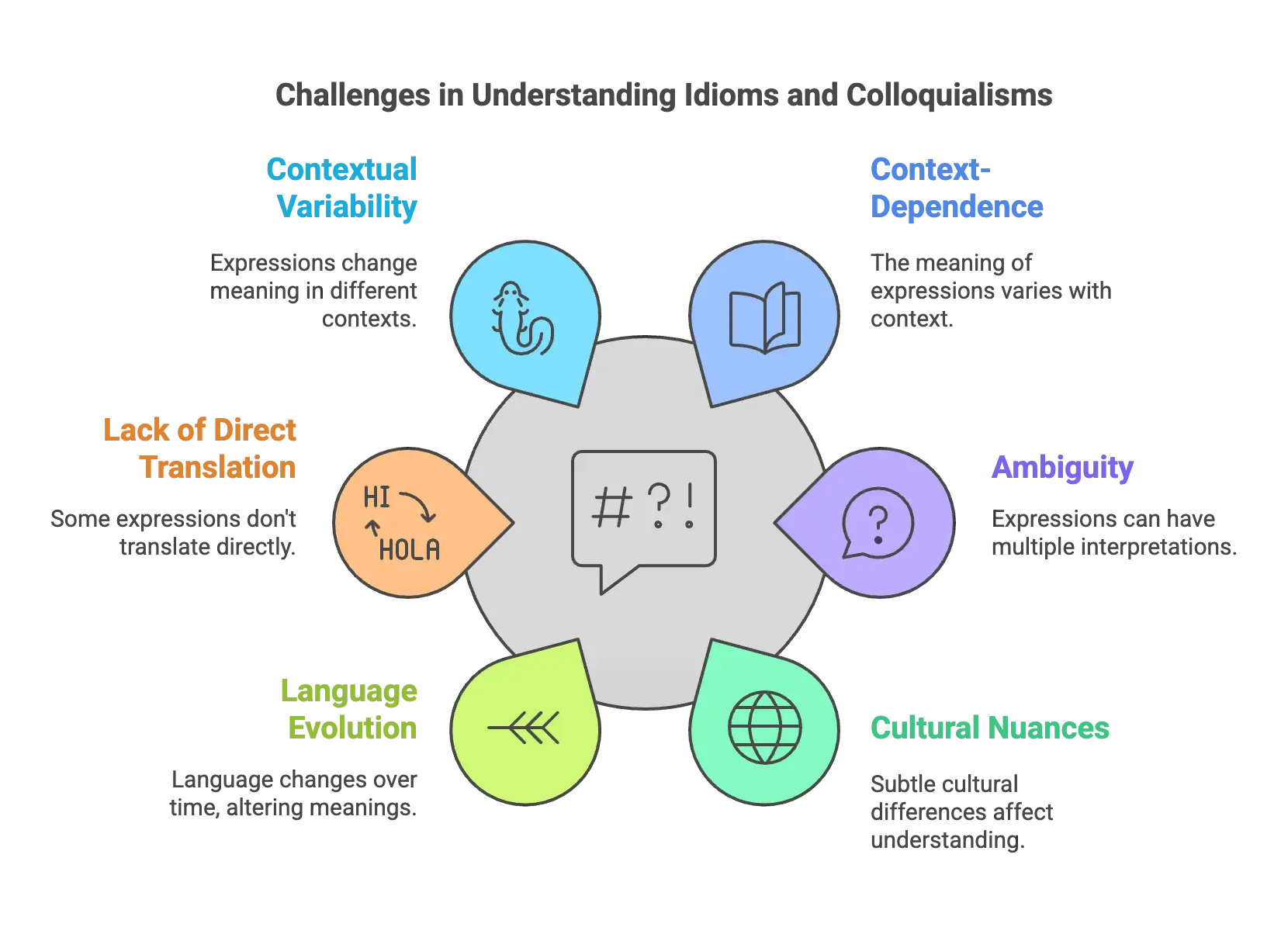
Challenges of Idioms and Colloquialisms
Idioms and colloquialisms bring several challenges in language learning and communication. These expressions are often deeply embedded in cultural contexts, leading to misunderstandings for non-native speakers and translators.
1. Context-Dependence
Idioms frequently rely on context for their meanings. For instance, “kick the bucket” refers to death, but this meaning can be missed without the right background. This reliance on situational cues can confuse learners who might interpret idioms too literally.
2. Ambiguity
Another issue is ambiguity. Many idioms can be understood in different ways. Take “hit the nail on the head,” meaning hitting a nail or describing someone as spot-on. This duality of meaning can confuse people who don’t know these phrases well.
3. Cultural Nuances
Cultural nuances are also significant. An idiom like “the early bird catches the worm” reflects cultural values regarding time that may not be accepted in other cultures. This cultural link means that students and translators need to understand the social background of these expressions.
4. Language Evolution
Language is evolving, and idiomatic phrases evolve, too. New idioms become trendy, and those commonly heard may disappear from usage, confusing learners and translators. For instance, younger generations may use idioms common to the younger generations that older speakers do not understand.
5. Lack of Direct Translation
Most idiomatic phrases do not have direct translations. For instance, in English, it is common to say, “It’s raining cats and dogs,” which does not have a direct translation in many other languages, potentially leaving the translator with challenges to try to communicate without changing the meaning of the phrase.
6. Contextual Variability
An idiom can have an abstract and contextual meaning. In other words, even though “barking up the wrong tree” refers to taking an incorrect course of action, evaluating the interpretation in the context of the surrounding discussion is necessary. This calls for a more precise understanding of the context for clear communication.
7. Cognitive Load for Learners
For language learners, mastering idioms increases cognitive load, as they must remember not only the phrases but also their meanings and appropriate contexts. Students can become overly tired of the dual task of processing grammar and vocabulary while contextualizing idioms correctly.
8. Emotional Connotations
Idioms often carry emotional weight that may not translate well. For example, the phrase “bit off more than he/she can chew.” In this case, a literal meaning may not convey how the idiom adds flavor to the length of their struggle. Having an understanding of these emotional elements is key to providing clear communication.
Idioms and colloquialisms present complex challenges that can significantly impact language learning and translation efforts. By recognizing ambiguity, cultural nuances, and language evolution, educators and translators can develop strategies to improve understanding and facilitate effective communication across cultures.
Addressing these challenges is essential for enhancing comprehension and fostering better interactions in diverse linguistic environments.
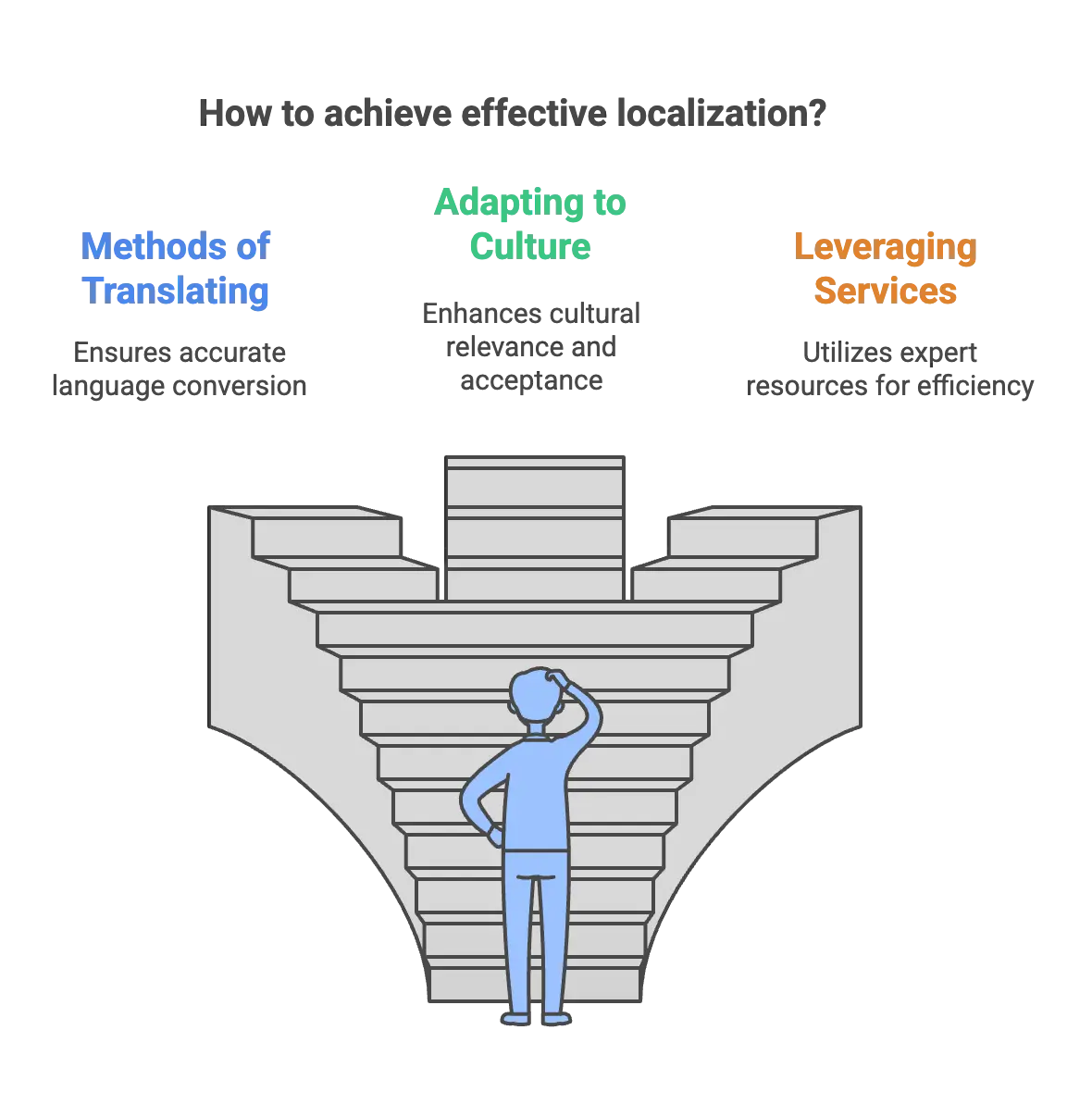
Strategies for Effective Localization
Companies must navigate challenges such as differing communication styles, social norms, and regional variations in language. Organizations can enhance their localization efforts by implementing targeted strategies and ensuring diverse stakeholders understand and appreciate their messages.
1. Methods of Translating
- Literal vs. Adaptive Translation: Deciding between literal and adaptive translation is essential. Literal translations frequently do not accurately communicate the desired message, whereas adaptive translation requires identifying culturally appropriate substitutes. For instance, translating the phrase “hit the ground running” might involve adjusting to a regional expression that communicates the idea of swift action.
- Contextual Understanding: Contextual comprehension is crucial to guaranteeing translations preserve the initial context and tone. Tools like SDL Trados and Memsource assist in achieving contextual accuracy and preserving idiomatic nuances.
2. Adapting to the Culture
- Studying Local Norms: Comprehending local cultural norms and communication styles is essential for successful localization. Levels of humor and formality differ significantly among cultures, leading to varying perceptions of politeness and humor that may not align across different cultural contexts.
- Involving Local Specialists: Working with native speakers and experts in localization can help guarantee that the content is culturally suitable and connects with the intended audience. These professionals assist in modifying idioms and phrases to conform to the customs and expectations of the specific region.
3. Leveraging Localization Services
- Choosing the Right Service Provider: Partnering with specialized localization services can enhance content quality. Providers like Lionbridge and TransPerfect offer expertise in handling complex localization needs, ensuring accurate adaptation of idioms in training and colloquialisms.
- Utilizing Technology: Modern localization technologies, including AI-based translation and machine learning, streamline the adaptation process and improve efficiency. These technologies help manage large volumes of content and ensure consistency across different languages.
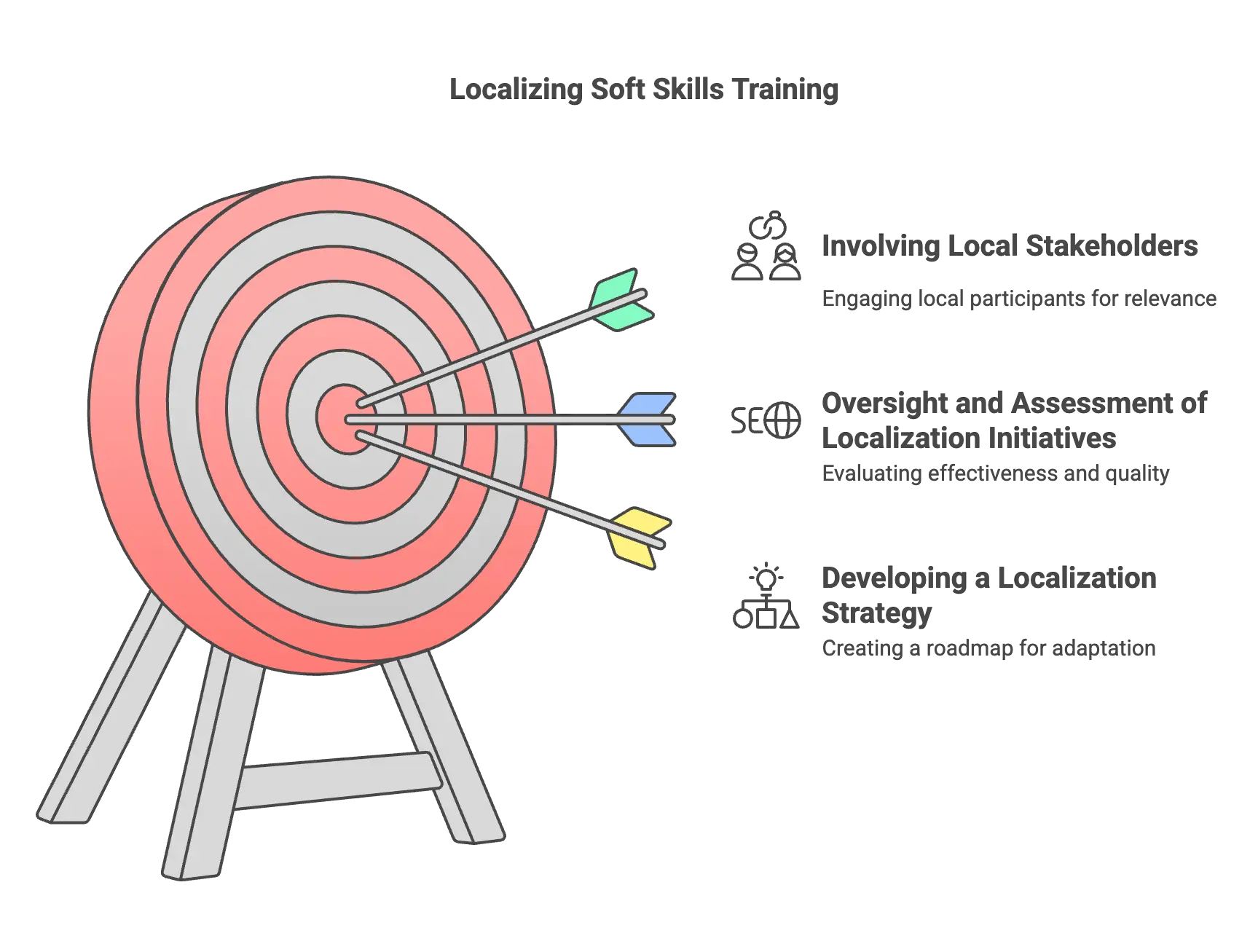
Best Practices for Localizing Soft Skills Training
The following are the best practices for soft skills localization training:
1. Developing a Localization Strategy
Creating a robust localization strategy involves understanding the target audience’s cultural and linguistic needs and developing a plan to adapt content accordingly. This strategy should align with the training objectives to ensure that localized content is relevant and practical.
2. Oversight and Assessment of Localization Initiatives
Organizations should monitor metrics like participant input, levels of engagement, and training results to measure the effectiveness of localization. Continuous assessment and adjustment with user input enhances the quality of tailored content and guarantees its relevance to various audiences.
3. Involving Local Stakeholders
Utilizing local partners during the localization process will guarantee that the training materials accurately represent the audience. Local partners can recognize crucial cultural nuances, preferences, and sensitivities that outsiders would not be able to detect, ultimately enhancing the effectiveness of the training.
The Takeaway
Building soft skills is as vital in workplace learning as domain and business skills. However, a few sessions in a physical classroom cannot build world-class soft skills. Soft skills training must be an ongoing, engaging process that offers workers opportunities for continuous practice.
Early investments in superior online training can help businesses identify key gaps and needs and build highly effective, data-driven training programs. This is an agile learning environment that companies can cost-effectively create.
If your business is looking to revamp its soft skills training strategy, consider partnering with Hurix Digital for its expertise in building superior tech-enabled frameworks for all your training needs. Our state-of-the-art Learning Management System is available both as a licensed version (one-time buy) and via a subscription model.
Reach out to us to start a conversation and leverage our superior soft skills virtual training models for your business.

A highly enthusiastic and motivated sales professional with over twenty five years of experience in solution selling of training-related applications and services. Maintains an assertive and dynamic style that generates results. Ability to establish long-term relationships with clients built on trust, quality of service and strategic vision. Specializes in financial services, higher ed, publishing and government in the areas of learning and development.




